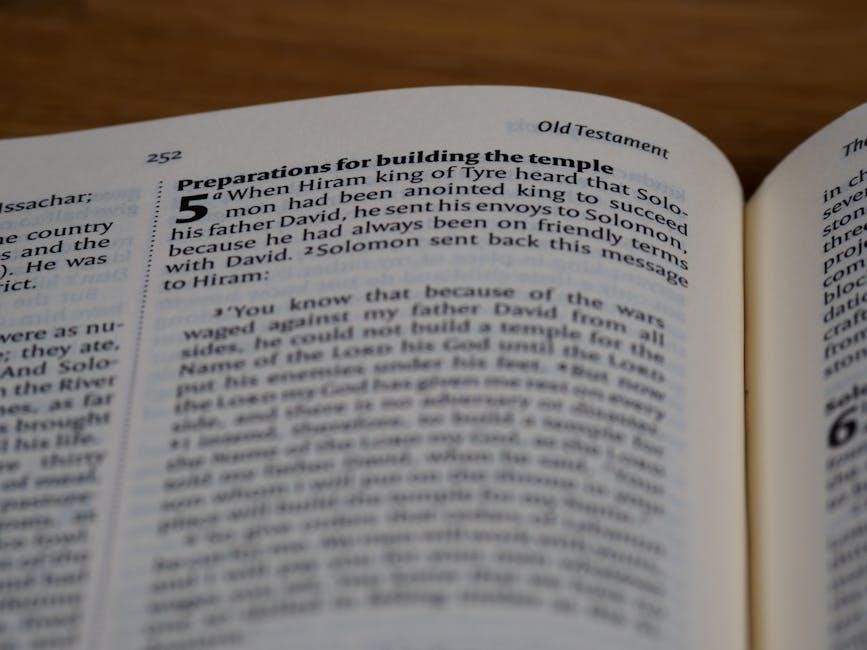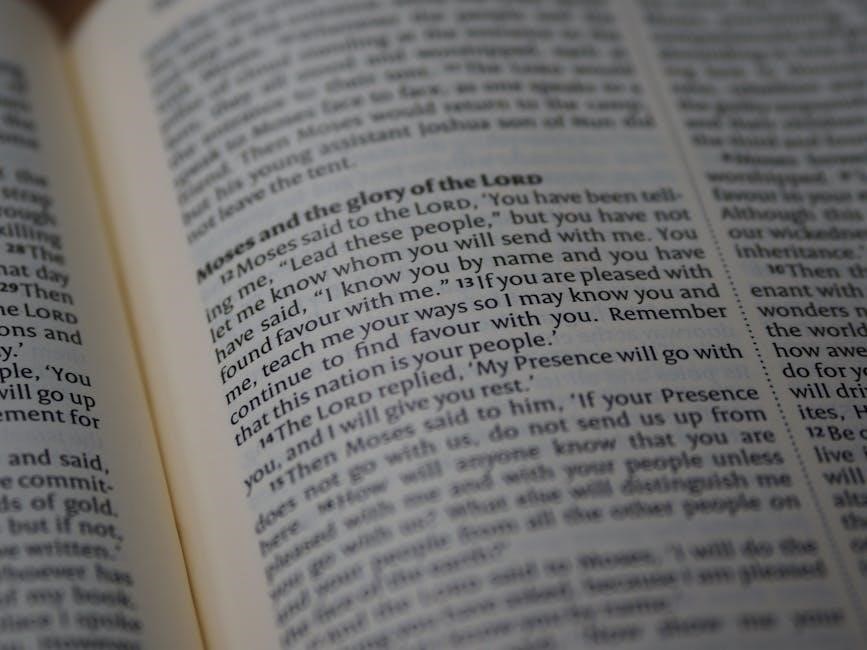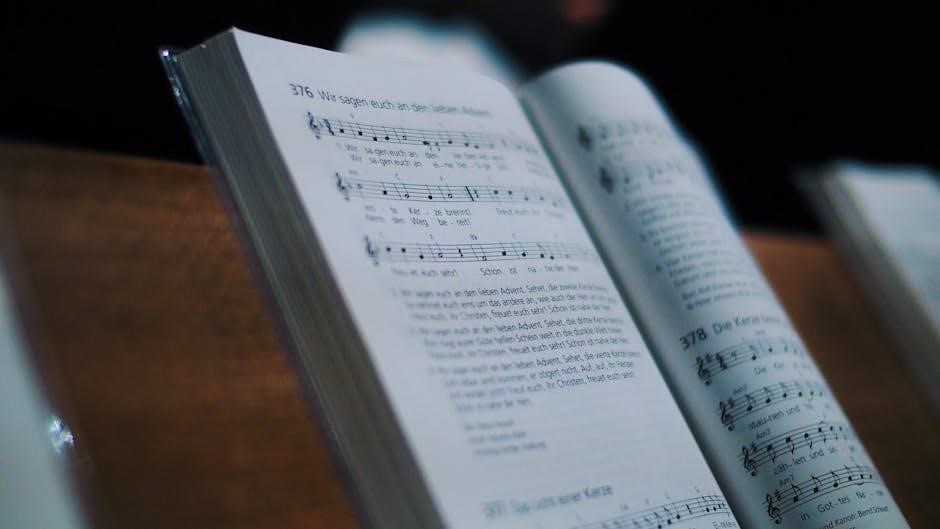
Song of Solomon Explained: Verse by Verse Analysis
Detailed verse-by-verse analysis of the Song of Solomon is available, often presented in PDF format․ This includes exploration of themes, literary devices, and interpretations․ Commentaries offer insights into each verse, clarifying meaning and historical context․ Study aids are useful for deeper understanding of scripture․
The Song of Solomon, also known as the Song of Songs or Canticles, is a unique book within the Old Testament․ It stands out for its passionate and sensual language, celebrating love and physical attraction between a man and a woman․ Unlike many other biblical books, God is not explicitly mentioned, leading to diverse interpretations and theological debates throughout history․

This poetic work is often understood as an allegory, representing the love between God and Israel, or Christ and the Church․ However, a more literal reading views it as a celebration of human love, marriage, and sexuality as God-given gifts․ The book’s rich imagery and symbolic language, drawn from nature and everyday life, create a vivid and evocative portrayal of romantic love․
Understanding the historical and cultural context is crucial for interpreting the Song of Solomon․ Its ancient Hebrew poetry utilizes various literary devices, such as metaphors, similes, and parallelism, to convey deep emotions and desires․ The absence of direct divine references challenges readers to consider the sacredness of human relationships and the beauty of intimate connection․
The Song of Solomon is essentially an extension of the Genesis concepts of the intrinsic goodness of sexuality, along with advice to guide us in its proper context․

Authorship and Title
The title “Song of Solomon” immediately raises questions about its origin and meaning․ The phrase “Song of Songs,” a Hebrew superlative, indicates that this is considered the most excellent or greatest of songs․ The attribution to Solomon in the first verse suggests he is either the author or the subject of the work․ Solomon, known for his wisdom and prolific writing, is credited with numerous proverbs and songs, making him a plausible candidate for authorship․
However, scholarly debate persists regarding the actual authorship․ Some argue that the language and style of the Song of Solomon differ from other works attributed to Solomon․ Others suggest that the book may be a collection of love poems compiled and attributed to Solomon due to his reputation as a wise and romantic figure․ Internal evidence, such as references to flora and fauna, points to a familiarity with the natural world, aligning with Solomon’s described knowledge․
Regardless of the precise authorship, the title signifies the importance and value placed on this collection of love poetry․ It highlights the beauty, passion, and intimacy expressed within the verses, elevating it above other songs․ The title invites readers to explore the depths of human love and its profound significance․
Themes of Love, Romance, and Sexuality
The Song of Solomon is celebrated for its candid exploration of love, romance, and sexuality within the context of marriage․ It presents a positive and affirming view of physical intimacy, portraying it as a natural and beautiful expression of love between a man and a woman․ The book rejects any sense of shame or guilt associated with sexual desire, instead emphasizing the joy and pleasure that can be found in a loving relationship․
The themes of love and romance are woven throughout the Song, expressed through poetic language, vivid imagery, and passionate dialogues․ The lovers express their admiration for each other’s beauty, confess their longing and desire, and celebrate the joys of physical union․ The Song highlights the importance of mutual respect, affection, and commitment in a successful relationship․
Sexuality is presented as an integral part of love and romance, not as something separate or taboo․ The Song celebrates the beauty of the human body and the pleasure of physical intimacy within the bounds of marriage․ It emphasizes the importance of consent, mutual enjoyment, and the deepening of emotional connection through physical closeness․ The Song of Solomon offers a refreshing and liberating perspective on love, romance, and sexuality, challenging traditional views that may be restrictive or negative․
Literary Analysis and Poetic Devices
The Song of Solomon is a masterpiece of Hebrew poetry, employing a rich array of literary devices to convey its themes of love, romance, and desire․ Its poetic structure is characterized by vivid imagery, metaphor, simile, and parallelism, creating a tapestry of sensory experiences that draw the reader into the world of the lovers․
Metaphors and similes are used extensively to describe the beauty of the lovers, comparing their features to natural elements such as gardens, mountains, and animals․ These comparisons not only enhance the aesthetic appeal of the poem but also convey deeper meanings about the nature of love and desire․
Parallelism, a common feature of Hebrew poetry, is used to emphasize key themes and create a sense of balance and harmony․ Repetition of phrases and ideas reinforces the emotional intensity of the poem, drawing the reader into the rhythm of the lovers’ passion․
The Song also employs other literary devices such as allegory, symbolism, and personification to add layers of meaning and complexity to the text․ These devices invite the reader to engage with the poem on multiple levels, exploring the spiritual and emotional dimensions of love․

Structure of the Song: A Chapter-by-Chapter Overview
The Song of Solomon, though not strictly adhering to a linear narrative, exhibits a discernible structure that guides the reader through its exploration of love․ It can be broadly divided into sections that highlight different aspects of the relationship between the lovers, from initial longing to mature commitment․
Chapter 1 introduces the themes of desire and longing, setting the stage for the unfolding romance․ Chapter 2 celebrates the beauty of love, using imagery of springtime and nature to evoke the joy and passion of the relationship․
Chapter 3 features a night search and a wedding procession, symbolizing the challenges and triumphs of love․ Chapter 4 presents a detailed description of the bride’s beauty, emphasizing the physical and emotional attraction between the lovers․
Chapter 5 explores a difficult separation and eventual reunion, highlighting the resilience of love in the face of adversity․ Chapter 6 offers further praise of the bride, reaffirming her value and worth․ Chapter 7 celebrates physical beauty and sensuality, emphasizing the importance of physical intimacy in the relationship․
Finally, Chapter 8 culminates in consummation and enduring love, providing a vision of a mature and lasting relationship․
Chapter 1: Longing and Desire
Chapter 1 of the Song of Solomon immediately immerses the reader in the intense emotions of longing and desire․ The initial verses express the bride’s yearning for her beloved, using vivid imagery to convey the depth of her feelings․ She desires his kisses, finding his love more intoxicating than wine․
The chapter also introduces themes of self-awareness and humility․ The bride acknowledges her perceived flaws, confessing her “darkness” but also recognizing her inherent beauty․ She seeks direction and guidance from her beloved, expressing a desire to be near him and to understand his love․
The bride’s longing is not merely physical; it is a deep desire for connection and intimacy․ She yearns for fellowship and communion with her beloved, seeking to be fully known and fully loved․ The language used throughout the chapter is evocative and sensual, reflecting the passionate nature of the relationship․
The chapter establishes the foundation for the rest of the Song of Solomon, setting the stage for the unfolding love story․ It highlights the importance of desire, longing, and mutual attraction in the formation of a strong and lasting bond․
Chapter 2: Springtime and Love’s Beauty
Chapter 2 of the Song of Solomon paints a vivid picture of springtime, mirroring the blossoming love between the bride and groom․ The imagery is rich with descriptions of flowers, birds, and gentle breezes, creating a sense of renewal and romance․ The bride compares herself to a rose of Sharon and a lily of the valleys, highlighting her beauty and uniqueness․
The groom responds with admiration, declaring her to be like a lily among thorns, emphasizing her exceptional loveliness․ He expresses his desire to be with her, longing for her presence and affection․ The couple’s interactions are playful and intimate, filled with tender words and gestures․
The chapter also introduces elements of anticipation and longing․ The bride hears the voice of her beloved and eagerly anticipates his arrival․ She describes him as leaping upon the mountains and skipping upon the hills, portraying his eagerness to be with her․
The themes of beauty, desire, and anticipation intertwine to create a powerful and evocative portrayal of love․ The springtime setting symbolizes the blossoming of their relationship, while the couple’s interactions highlight the depth of their affection for one another․ Chapter 2 sets the stage for further exploration of their love story․
Chapter 3: The Night Search and Wedding Procession
Chapter 3 of the Song of Solomon presents two distinct scenes: a night search by the bride and a grand wedding procession․ The night search depicts the bride’s anxious quest for her beloved, symbolizing longing and the desire for reunion․ She wanders through the city, questioning watchmen about his whereabouts, highlighting her unwavering devotion․
The wedding procession, in contrast, is a display of regal splendor and celebration․ King Solomon is carried on a palanquin, surrounded by valiant guards, showcasing his power and status․ The daughters of Jerusalem are invited to behold the king in his glory, emphasizing the magnificence of the occasion․
These contrasting scenes create a dynamic tension within the chapter․ The bride’s solitary search emphasizes the personal and intimate nature of love, while the wedding procession highlights the public and communal aspect of marriage․ The chapter also underscores the themes of anticipation, commitment, and celebration․
The night search can also symbolize the spiritual journey of seeking God, reflecting the longing of the soul for divine connection․ Meanwhile, the wedding procession celebrates the union of two souls, representing the ultimate fulfillment of love and commitment․ Together, these scenes offer a multifaceted perspective on love and relationships․
Chapter 4: The Bride’s Beauty Described
Chapter 4 of the Song of Solomon is a detailed and passionate ode to the bride’s physical beauty․ The groom uses vivid and poetic language to praise her from head to toe, comparing her features to various elements of nature and precious objects․ This chapter is renowned for its rich imagery and sensual descriptions․
He begins by describing her eyes as doves behind her veil, suggesting innocence and purity․ Her hair is likened to a flock of goats descending Mount Gilead, emphasizing its abundance and cascading beauty․ Her teeth are compared to a flock of shorn ewes, highlighting their whiteness and evenness․
The groom continues to praise her lips, likening them to a scarlet ribbon, and her mouth as lovely․ Her temples are compared to a piece of pomegranate behind her veil, suggesting a delicate and alluring beauty․ Her neck is likened to the tower of David, adorned with shields, symbolizing strength and elegance․
He then describes her breasts as twin fawns that graze among the lilies, emphasizing their beauty and tenderness․ The chapter concludes with the groom inviting his bride to come away with him, highlighting the intimacy and exclusivity of their love․ This chapter celebrates physical beauty as an integral part of love and attraction․
Chapter 5: A Difficult Separation and Reunion
Chapter 5 of the Song of Solomon portrays a poignant episode of separation and eventual reunion between the lovers․ This chapter highlights the complexities of love, including moments of miscommunication, regret, and the overwhelming joy of reconciliation․
The bride recounts a night when the groom arrives at her door, seeking entry․ She hesitates to open the door, offering excuses for her reluctance․ During her delay, the groom departs, leaving her filled with regret and longing․ This moment symbolizes the potential for separation and the pain of missed opportunities in love․
Overcome with remorse, the bride ventures out into the city in search of her beloved․ Her search is fraught with difficulty, as she encounters watchmen who mistreat her․ This experience underscores the vulnerability and challenges one faces when seeking love․ Finally, she pleads with the daughters of Jerusalem to help her find him․
The chapter concludes with the bride describing her beloved’s unparalleled beauty, emphasizing his radiant appearance and captivating presence․ This description reignites the desire and longing for reunion․ While the specific moment of reunion isn’t explicitly described, the chapter leaves the reader with a sense of hope and anticipation for the lovers to be together again․
Chapter 6: Further Praise of the Bride
Chapter 6 of the Song of Solomon continues the theme of admiration and adoration, focusing on the groom’s lavish praise of the bride’s beauty․ The chapter opens with the daughters of Jerusalem inquiring about the groom’s whereabouts, prompting a renewed description of the bride’s captivating features․
The groom embarks on an extensive and detailed description of his beloved, comparing her beauty to various natural and architectural wonders․ He marvels at her physical appearance, highlighting her eyes, hair, teeth, and other features․ These descriptions serve to emphasize her perfection and the deep affection he holds for her․
Throughout the chapter, the groom uses metaphors and similes to convey the bride’s unparalleled beauty․ He compares her to a banner, a majestic city, and a flock of sheep․ These comparisons paint a vivid picture of her radiant appearance and the powerful impact she has on him․
The bride’s presence evokes a sense of awe and wonder in the groom․ He finds himself captivated by her every move, her every glance․ This chapter serves as a testament to the enduring power of love and the ability of one person to inspire profound admiration and devotion in another․
Chapter 7: Celebration of Physical Beauty
Chapter 7 of the Song of Solomon presents a continued and heightened celebration of the bride’s physical beauty, further solidifying the Song’s focus on the joys of physical intimacy within the context of love․ This chapter features a detailed and sensual description of the bride from head to toe, using vivid imagery to convey her allure․
The groom’s words are filled with admiration and desire, as he compares her various body parts to objects of natural beauty and artistic creation․ He praises her hair, her lips, her breasts, her waist, and her legs, each receiving a unique and flattering comparison․ These poetic descriptions are intended to evoke a sense of delight and appreciation for the beauty of the human form․
The chapter is characterized by a playful and intimate tone, as the groom expresses his longing for his beloved․ He speaks of wanting to savor her presence and to indulge in the pleasures of their physical union․ This chapter underscores the idea that physical intimacy is a natural and beautiful expression of love, to be celebrated and enjoyed within the bonds of marriage․
The celebration of physical beauty in Chapter 7 serves to deepen the reader’s understanding of the Song of Solomon as a whole, highlighting its affirmation of the goodness of the body and the importance of physical attraction in a loving relationship․
Chapter 8: Consummation and Enduring Love

Chapter 8 of the Song of Solomon brings the love story to its culmination, emphasizing the themes of consummation and enduring love․ This chapter reflects on the deep bond between the lovers and looks forward to a future filled with unwavering commitment․
The bride expresses a longing for a more public display of affection, desiring to be seen openly with her beloved․ She envisions a relationship that is not confined to private moments but is celebrated and recognized by the community․ This speaks to the desire for a love that is both passionate and publicly affirmed․
The chapter also touches on the themes of jealousy and the strength of love to withstand adversity․ Love is portrayed as an unquenchable fire, a force that cannot be extinguished by any obstacle․ This highlights the enduring nature of the love between the bride and groom․
As the Song of Solomon draws to a close, it leaves the reader with a sense of hope and optimism about the power of love to overcome challenges and to last a lifetime․ The final verses celebrate the consummation of their love and the promise of a shared future, emphasizing the beauty and importance of enduring love within a committed relationship․